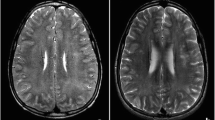Summary
A case of accidental monointoxication caused by diphenhydramine is reported. Having taken 12 dragées of Neo-Emedyl (50 mg diphenhydramine), an 18-month-old girl showed the following symptoms: generalized erythema, dyspnoea, vomiting, hyperpyrexia, tremor, convulsions, coma, respiratory arrest and absence of reflexes. Computed tomography (CT) suggested a massive cerebral oedema. Her electroencephalogram was abnormally diffused at first; later on, it flattened significantly and became isoelectric between the 14th day and the final stoppage of circulation (after 5 weeks).
Autopsy revealed total necrosis of the brain, with the venous cerebral blood vessels being thrombosed (the morphological basis for dissociated cerebral death). In autolysed brain tissue, diphenhydramine was detected at a concentration of 30 ng/g by GC/MS (gas chromatography, mass spectrometry); the concentration of the substance was less than 10 ng/g in the liver. The relatively high concentration in the brain was due to the previous blocking of the circulation.
Cerebral death syndrome caused by intoxication offers the chance of detecting measurable amounts of the unchanged drug in autolysed brain tissue.
Zusammenfassung
Bericht über eine akzidentelle Monointoxikation mit Diphenhydramin. Bei einem 18 Monate alten Mädchen traten nach Einnahme von 12 Dragees Neo-Emedyl® (à 50 mg Dimenhydrinat) folgende Symptome auf: generalisiertes Erythem, Dyspnoe, Erbrechen, Hyperpyrexie, Tremor, Krämpfe, Koma, Atemlähmung, Reflexlosigkeit. Der CT-Befund ließ auf ein massives Hirnödem schließen. Das EEG war zunächst diffus abnorm, dann stark abgeflacht und vom 14. Tag bis zum endgültigen Kreislaufstillstand (nach 5 Wochen) isoelektrisch. Autoptisch fand sich eine Totalnekrose des Gehirnes mit thrombotischer Obstruktion der venösen Hirngefäße (als morphologisches Substrat des dissoziierten Hirntodes). Im erweichten Hirngewebe wurde mittels kombinierter GC/MS Diphenhydramin in einer Konzentration von 30 ng/g nachgewiesen; in der Leber lag der Wirkstoffspiegel unter 10 ng/g. Die verhältnismäßig hohe Konzentration im Gehirn war auf den frühzeitigen Durchblutungsstop zurückzuführen. Bei toxisch ausgelöstem Hirntodsyndrom besteht also die Möglichkeit, daß die vom übrigen Kreislauf abgegrenzte, autolytische Hirnsubstanz selbst nach einigen Wochen noch meßbare Mengen des unveränderten Arzneimittels enthält.
Similar content being viewed by others
Literatur
Aaron FE (1953) A case of acute diphenhydramine hydrochloride poisoning. Br Med J 2:24
Aderjan R, Bösche J, Schmidt G (1982) Vergiftungen mit Diphenhydramin — Forensischtoxikologische Beurteilung von Analysenbefunden. Z Rechtsmed 88:263–270
Altorfer R (1981) Vergiftungen mit Diphenhydramin. Schweiz Rundschau Med (Praxis) 70:711–716
Arnold W, Püschel K (1980) Toxicological findings after abuse of narcotics. In: Kovatsis A (ed) Toxicological aspects. Proc 9th Int Congr of the European Ass of Poison Control Centers and the European Meeting of the Int Ass of Forensic Toxicologists (Thessaloniki 24.–27.8. 1980), pp 248–251
Borkenstein M, Haidvogl M (1978) Treatment of ingestion of diphenhydramine. J Pediat 92:167
Brugsch H, Klimmer OR (1966) Vergiftungen im Kindesalter. Enke, Stuttgart, S 51–53
Chang T, Okerholm RA, Glazko AJ (1974) Identification of diphenhydramine (Benadryl) metabolites in human subjects. Res Commun Chem Pathol Pharmacol 9:391–404
Davis JH, Hunt HH (1949) Accidental Benadryl poisoning: report of a fatal case. J Pediat 34:358–361
Flechsig W (1959) Zur Antihistamin-Vergiftung. Kinderärztl Prax 27:280–282
Gibb B, Giebelmann R, Maier E (1964) Tödliche Vergiftung mit dem Antihistaminikum AH3. Dtsch Gesundheitswes 19:1289–1293
Giertz H (1975) Vergiftung durch Antihistaminika. In: Forth W, Henschler D, Rummel W (Hrsg) Pharmakologie und Toxikologie. Bibliographisches Institut, Mannheim Wien Zürich, S 153
Gill-Carey MC (1954) Chlorcyclizine hydrochloride poisoning in an infant. Br Med J 1:687–688
Glazko AJ, Dill WA, Young RM, Smith TC, Ogivie RI (1974) Metabolic disposition of diphenhydramine. Clin Pharmacol Ther 16:1066–1076
Hausmann E, Wewer H, Wellhöner HH, Weller JP (1983) Lethal intoxication with diphenhydramine. Report of a case with analytical follow-up. Arch Toxicol 53:33–39
Haveric D, Stern P (1956) Vergiftungen mit Antihistaminica. Arch Toxikol 16:139–142
Hestand HE, Teske DW (1977) Diphenhydramine hydrochloride intoxication. J Pediat 90:1017–1018
Hladny J (1982) Akute Psychosen durch Intoxikation mit Diphenhydramin. MMW 124:977–978
Huxtable RF, Landwirth J (1963) Diphenhydramine poisoning treated by exchange transfusion. Am J Dis Child 106:496–500
Iffland R, Staak M (1981) Zum Aussagewert der Alkoholbestimmung im Hämatomblut. Blutalkohol 18:341–353
Jochum K, Patscheider H, Scheibl F (1957) Tödliche Vergiftung mit Neo-Antergan bei einem Kleinkind. Der Nachweis von Antihistaminkörpern in faulenden Organteilen. Arch Toxikol 16:237–242
Judge DJ, Dumars KW (1953) Diphenhydramine (Benadryl) and tripelenamine (Pyribenzamine) intoxication in children. Am J Dis Child 85:545–550
Klug E (1980) Zur Morphinbestimmung in Kopfhaaren. Z Rechtsmed 84:189–193
Köhler HJ (1957) Beitrag zur akuten Antihistamin-Vergiftung. MMW 99:1705–1706
Lembeck F, Lipp W, Maresch W (1960) Vergiftungen durch Neo-Antergan im Kleinkindesalter. Arch Toxikol 18:93–106
Machata G (1960) Über den Antihistaminnachweis in Leichenorganen. Arch Toxikol 18:124–130
Moldenhauer E, Kupatz H (1970) Intoxikation durch antihistaminhaltiges Gelee bei einem Kind. Dtsch Gesundheitswes 25:231–233
Nigro SA (1968) Toxic psychosis due to diphenhydramine hydrochloride. JAMA 203:139–140
Oberst BB (1955) Accidental fatal Dibestine poisoning. J Pediatr 46:451–452
Oehme J (1984) Säuglings- und Kindesalter. In: Kuemmerle HP, Goossens N (Hrsg) Klinik und Therapie der Nebenwirkungen. Thieme, Stuttgart New York, S 913
Reichelderfer ThE, Livingston S, Auld RMcG, Peck JL (1955) Treatment of acute Benadryl (diphenhydramine hydrochloride) intoxication with severe central nervous system changes and recovery. J Pediat 46:303–307
Reyes-Jacang A, Wenzl JE (1969) Antihistamine toxicity in children. Clin Pediat 8:297–299
Rumack BH (1973) Anticholinergic poisoning: treatment with physostigmine. Pediatrics 52:449–451
Schebeck K (1954) Atosilvergiftung bei einem Kinde. Kinderärztl Prax 22:543–548
Schipior PG (1967) An unusual case of antihistamine intoxication. J Pediat 71:589–591
Schneider H, Matakas F (1973) Zur Morphologie des Hirntodes. In: Krösl W, Scherzer E (Hrsg) Die Bestimmung des Todeszeitpunktes. Maudrich, Wien, S 213–221
Wölkart N (1955) Über den Tod durch Antihistaminica. Beitr Gerichtl Med 20:74–80
Wyngaarden JB, Seevers MH (1951) The toxic effects of antihistaminic drugs. JAMA 145:277–282
Author information
Authors and Affiliations
Additional information
Herrn Prof. Dr. G. Machata zum 60. Geburtstag gewidmet
Rights and permissions
About this article
Cite this article
Vycudilik, W., Pollak, S. Nachweis von Diphenhydramin im autolytischen Hirngewebe bei toxisch bedingtem Hirntodsyndrom. Z Rechtsmed 95, 129–135 (1985). https://doi.org/10.1007/BF00201193
Received:
Issue Date:
DOI: https://doi.org/10.1007/BF00201193
Key words
- Diphenhydramine, fatal intoxication
- Cerebral death syndrome
- Detection of drugs in autolytic brain tissue




